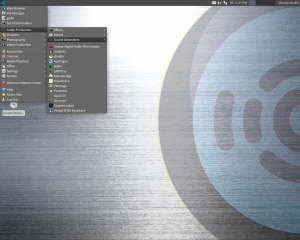Many years ago I wrote a series on “reviving your old PC with Linux“, a topic which still remains in active discussion all around the Linuxy corners of the Interwebs. Most of what I wrote still applies, so long as you shift things forward seven years into the future. But as someone who continues to engage in the hobby (and discussion of the hobby) of foisting free operating systems on whatever decaying PC hulks float my way, I thought I’d write up random thoughts about the subject in response to things people say or the changes in computing. A bit of a rant, a bit of state-of-the-union, and a little thinking out-loud on the topic of old hardware running old faithful.
Friday Fun: Linux on an old point-of-sale
On the bench today: a mysterious black point-of-sale system recently retired from use at a Parks facility. This victim of the end-of-XP upgrades landed on my desk since it wouldn’t run Windows 7, to see if it could be made useful with Linux.
SolydX: Can it replace your XP?
At some point in my Linux-user career, I realized that my “perfect distro” setup (currently Arch with Awesome WM) – while great for me – was about as far removed from “average user” territory as you can get. So from time to time, I like to check out distributions that might be good to recommend to new users who want to find out what this Linux thing is all about.
With all the hubbub this month about Windows XP’s end-of-life, I thought I’d do a review of a relatively new distribution that has caught my eye as a possible contender for both users and hardware accustomed to the newly-legacied OS. (more…)
Reviving your old PC with Linux, Part VI: Building your own lightweight remix
In the previous article of this series, I covered a variety of “remix” distributions of Linux aimed at older computers, and posed the question “why not build our own”? In this article, we’ll look at doing exactly that.
Our goal will be to set up a basic desktop system, using only the necessary components, such that it will run reasonably well on a roughly ten-year-old computer.
Porteus
As I’ve chronicled in “Replacing Windows 98…” and previous posts, I’m always interested in new tools that promise to imbue my mountain of mouldering beige boxen with a glorious desktop experience usable by the modern user. A commenter on that post suggested trying out Porteus, so I’ve been playing with it some this evening. While I haven’t time to work up a serious review, I thought I’d share my impressions of Porteus as a distro for rescuing older computers.
Ubuntu Studio 12.04
Not so long ago, I posted about my attempts to bring my old DAW system back to life with Lubuntu. Emboldened by my success, and eager to get it on a nice firm LTS-release foothold, I tried to upgrade it to Precise Pangolin a few weeks ago. Sadly, the results were not so great: after upgrading, I ran afoul of a mysterious bug that caused Ardour, Audacity, and Hydrogen (and possibly other programs) to segfault when I started them. Despite my best efforts to track down the error (probably caused by my liberal use of PPAs and 3rd-party repositories), it became clear I needed to start afresh.
This time I decided to skip a bit of the DIY and just grab a ready-made audio production distro; after all, there are plenty of them out there, aren’t there? Well, the hunt began for an audio-production oriented distro that would work decently on an older 32-bit system while promising future updates; and yes, believe me, my not-so-fond-of-Ubuntu friends out there, I didn’t limit myself to ‘buntuland. Yet search as I might, every project I found seemed either at least 18 months stale (if not out-and-out abandoned), or a one-man project based on Debian or Ubuntu anyway. In the end, Ubuntu studio seemed best to fit the bill. So I downloaded the nearly 2 GB .iso file, popped it on my flash drive, and loaded it onto the old workhorse; and here, dear reader, are my findings so far…
Recovering data from a PC: a guide for “not computer people”
It’s a little unfortunate how much we rely on something as unreliable as a computer. There you are, working along, happily doing your thing, and suddenly Windows (or OSX, or Linux, or BEOS, or whatever it is that sits between your hardware and your web browser) pukes up some error and refuses to boot, work, or be otherwise useful.
Fixing the computer itself is just a matter of time and money; getting back those pictures, documents, emails, and other files that you always meant to back-up is another issue. So in this article I’m going to show you a simple way to recover documents from a system that won’t boot.
Reviving my home studio, this time the free software way
Long ago, before I ever knew a lick of BASH or even what an OS kernel was, my passion was not technology but music, music, and more music. Roughly the first half of my adult life was devoted to the writing, playing, and recording of music, and by around 2002 I’d built for myself a tidy little home recording & mixing setup centered on Cakewalk Sonar, Jeskola Buzz, and Windows XP. Alas, the years were not kind to my career or gear, and up until recently my music computer was busy being a game & education machine for the kids.
Thanks to a hard drive crash and the purchase of new machines for the kids, I got my old music machine back, albeit lacking a functioning operating system and software. So, I decided now was a good time to rebuild it. This time, though, I decided the time was right to kick XP and Cakewalk to the curb and go it Free Software style.

 The Amiga. If you weren’t of computing age during the Bush Sr. administration, you may not have heard of this legend wrapped in an enigma wrapped in a white case. The Amiga inspired frenzied superlatives from its users (including, notably, pop artist
The Amiga. If you weren’t of computing age during the Bush Sr. administration, you may not have heard of this legend wrapped in an enigma wrapped in a white case. The Amiga inspired frenzied superlatives from its users (including, notably, pop artist 
